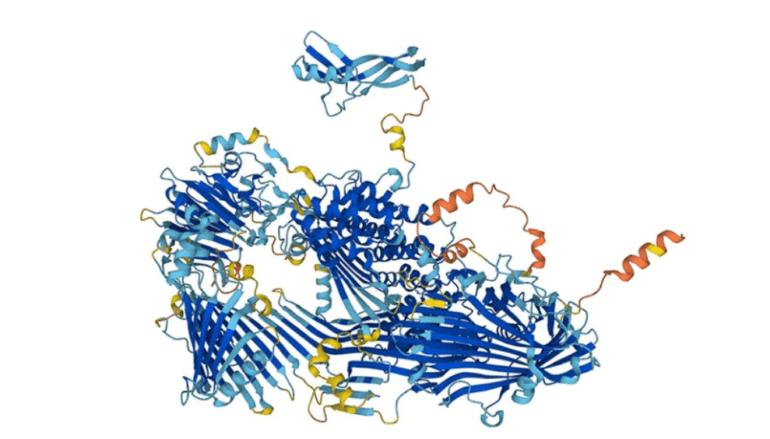TL;DR:
- AlphaFold’s protein-structure-prediction tool identifies numerous potential psychedelic molecules for antidepressant development.
- Its predictions prove as valuable as experimentally derived protein structures, significantly expediting drug discovery.
- Initial skepticism about AlphaFold’s efficacy in drug discovery is challenged by recent research.
- AlphaFold excels in identifying drugs that activate serotonin receptors, holding promise for non-hallucinogenic antidepressants.
- AlphaFold demonstrates a 60% hit rate in identifying drugs for G-protein-coupled receptors.
- Predicted protein structures are not universally applicable but could jump-start projects in one-third of cases.
- Isomorphic Labs, DeepMind’s drug-discovery spin-off, secures substantial deals with pharmaceutical giants to leverage AlphaFold’s capabilities.
- AlphaFold’s evolving potential, including predicting protein structures bound to drugs, promises continued contributions to drug discovery.
Main AI News:
AlphaFold, the groundbreaking protein-structure-prediction tool developed by DeepMind, has recently unveiled its potential to revolutionize drug discovery. Through its computational prowess, AlphaFold has identified hundreds of thousands of potential new psychedelic molecules, opening doors to the development of novel antidepressants. This development marks a significant milestone, demonstrating that AlphaFold’s predictions, easily accessible with a click, can be as invaluable as experimentally derived protein structures, which traditionally consume months or even years to establish.
AlphaFold’s contribution to drug discovery, however, has faced its share of skepticism in the scientific community. Some experts questioned whether AlphaFold’s predictions could truly replace the gold standard of experimental models in the search for new drugs. Brian Shoichet, a pharmaceutical chemist at the University of California, San Francisco, voiced concerns regarding the hype surrounding AlphaFold’s potential, urging caution.
Previous studies had indicated that AlphaFold’s predictions were less effective than experimental methods, such as X-ray crystallography, in identifying potential drugs through protein-ligand docking. Nevertheless, researchers led by Shoichet and Bryan Roth at the University of North Carolina at Chapel Hill embarked on a mission to investigate further.
Their research compared AlphaFold structures of two proteins implicated in neuropsychiatric conditions against known drugs, discovering a striking divergence in the drug candidates identified. Surprisingly, despite the differences, the ‘hit rates’—the proportion of flagged compounds altering protein activity—were nearly identical for both predicted and experimental structures. AlphaFold, in fact, excelled in identifying drugs that activated the serotonin receptor, a significant breakthrough in the quest for non-hallucinogenic antidepressants.
In additional research, AlphaFold demonstrated a remarkable 60% hit rate in identifying drugs for G-protein-coupled receptors, a sought-after target class. This newfound confidence in predicted protein structures could significantly reshape the landscape of drug discovery, reducing the reliance on time-consuming experimental methods.
While AlphaFold’s potential is undeniable, it is not a universal panacea. Predicted structures prove valuable for some drug targets but not others, making it essential to discern their applicability. In approximately 10% of cases, AlphaFold’s predictions may substantially differ from experimental structures.
However, the benefits are substantial. Shoichet estimates that in about one-third of cases, an AlphaFold structure could expedite a project by a couple of years, a game-changing advantage. Isomorphic Labs, DeepMind’s drug-discovery spin-off, has already embarked on this transformative journey, securing deals worth up to $2.9 billion with pharmaceutical giants Novartis and Eli Lilly to harness AlphaFold’s machine-learning capabilities.
AlphaFold’s journey doesn’t end here, as it continues to evolve. The company’s plans to predict protein structures when bound to drugs and other interacting molecules hint at even more promising applications. While these tools won’t entirely replace experiments, their potential to facilitate drug discovery should not be underestimated. Striking a balance between technology and traditional methods remains a challenge, but AlphaFold’s undeniable contributions point towards a bright future for pharmaceutical innovation.
Conclusion:
AlphaFold’s integration into drug discovery processes signifies a paradigm shift in the pharmaceutical market. While not a universal solution, its ability to accelerate drug development, particularly in targeting specific receptors, has garnered significant interest from industry leaders. The partnership between Isomorphic Labs and major pharmaceutical companies underscores the growing influence of AI-driven solutions in the pharmaceutical industry, marking a transformative period in drug innovation and development.

